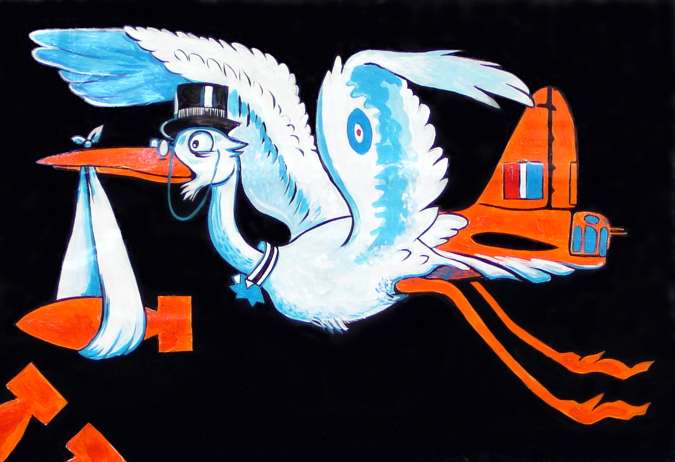 Nose Art
Nose Art  |
BCATP
|
Lancaster
|
Media
|
BCATP
|
Lancaster
|
Media
 Nose Art
Nose Art  |
BCATP
|
Lancaster
|
Media
|
BCATP
|
Lancaster
|
Media
Nose Art

During World War II, the personalization of an aircraft by giving it a name, painting an image on it, and in many cases doing both began in the early months of the war, increased in frequency as the war progressed, and reached its peak in 1945. In the case of bombers, a bomb tally was often added as well and this provided a powerful visual record of the success and longevity of the aircraft. In some cases, additional information such as whether an operation was a day raid or a night raid and the type of weapons carried were also noted. The destruction of enemy fighters was sometimes indicated and often other details such as awards received by aircrew while flying the aircraft.
If a bomber crew was assigned a particular aircraft, they were sometimes able to choose the name and artwork and this enabled a powerful bond to develop between the men and the machine. Often, but not always, the name and the artwork were directly related to the letter designation for the particular aircraft within the squadron. The markings on fuselages of Royal Air Force and Royal Canadian Air Force aircraft were made up of a two letter squadron code, such as "EQ," that in combination with a single letter designator for the aircraft, such as "N," produced a unique identifier, in this case "EQ-N." So, for example, if a crew were assigned the squadron's "D" aircraft, names such as "D for Daisy," "Devastating Dog," or "Dipsy Doodle" were possibilities.
The vast majority of World War II aircrew were in their very early twenties and many even flew wartime operations while in their teens. So it is not surprising that the majority of the nose art reflects their interest in "pin-up" girls of the day and other images related to their interest in the opposite sex. However cartoon characters were popular subjects as well, many of them created by Walt Disney.
There were likely several hundred different nose arts painted on aircraft operated by Canadian aircrew. The presence of cameras on wartime bases was actively discouraged so in many cases, nose art was painted on an aircraft and the aircraft was lost before even an "unofficial" photograph could be taken. In other cases only poor quality, distant shots of a nose art adorned bomber were taken and, of course, during the early 1940's colour photos were very rare. At war's end, there was little interest and thousands of aircraft were scrapped with little note being taken of any artwork.
In his book, "RAF and RCAF Aircraft Nose Art in World War II," Clarence lists the names of 23 Canadians who are known to have painted nose art. Although some were aircrew, 65% were "Erks," ground crew aero-engine mechanics, airframe mechanics and others with ranks of corporal or below. Like the aircrew, most were very young as well and had no formal training in art. An exception was Thomas Dunn who painted nose art on twelve Halifax Bombers had painted signage on trucks prior to the war.
It appears the selection on individual to paint the nose art on an aircraft was an informal process. Someone on the squadron with an interest in art, an idea, and the motivation would simply volunteer to do the work. In some cases, after establishing a reputation, the nose artist would charge for his work. Often payment was simply a night of free beer at the squadron pub but some took the opportunity to charge as much as five pounds to do the work.
"Muff" Mills is the only Canadian known to have used his wartime nose art experience to launch a career. "Muff" went on to become an art director and political cartoonist.
The panels that make up The Clarence Simonsen Collection have been donated to the Bomber Command Museum over a number of years during which Clarence has contributed to the museum in several different ways.
Many of his panels were painted when Clarence saw an opportunity to create artwork that complimented a particular display in the museum or a special event that we were having while others were inspired by our acquisition of the full-size Lancaster replica cockpit section and our acquisition of large Lancaster wing panels that he saw as perfect "canvasses". His knowledge of the history related to the art enabled him to see opportunities to do this when those of us at the museum were unaware of the possibilities.
Clarence's artwork is based on black and white wartime photographs, many of which were not necessarily focused on the nose art and, because they were taken by amateur photographers with relatively primitive equipment during hectic wartime days, are generally not of the best quality. But Clarence has brought these images to life by painting his wonderful nose art replicas in colour and with a freshness and clarity that enables us to appreciate the power and impact they had during World War II.
The other aspect of his work that makes it so special is that all of the paintings have been done on aircraft skin, in all but one case aluminum, that has flown as part of a World War II Bomber or training aircraft. The various panels and rivets provide a rich background texture that makes his work much more meaningful and directly connects it to his subject. In many cases, the original paint from the wartime aircraft remains around the edges of the nose art.
The museum is honoured to be able to present to our visitors, both at the museum and to our website, the finest collection of aircraft nose art replica paintings in Canada.